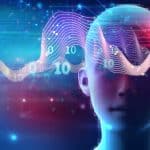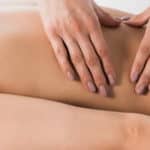We are a society that works too much and exercises too little. We live longer than previous generations and tend to eat less nutritious food. As a result we have an aging population that increasingly experiences problems with our backs.
One of the most common causes of upper back pain is cervical stenosis, or a narrowing of the vertebral canal in the C4 – C7 region. This narrowing can be caused by any number of things such as trauma, degenerative disc disease or spondylosis (spinal osteoarthritis). It is a condition that can also be present at birth. As time goes on the spinal canal can continue to narrow until it begins to press on the spinal cord and/or the spinal nerves.
Anatomy of a Spine
The spinal column is made up of 24 individual vertebrae in the cervical, thoracic and lumbar regions, plus the fused sacral and coccygeal bones. The cervical vertebrae (C1 –C7) help to support the head and allow it to rotate, laterally flex and have anterior/ posterior flexion and extension. As with the lower spine, the structure of the cervical vertebrae form a kind of tunnel, or vertebral canal, which protects the spinal cord and nerves that exit through the vertebral foramina. In between each vertebra is an intervertebral disc that cushions the bones and helps make movement and flexibility possible. It is when the normal anatomy of the vertebrae is compromised that pain and other somatic problems can arise.
In cases of cervical stenosis the vertebrae in the neck may start to impinge on the spinal cord, which in turn can impede movement and affect various normal physical functions just about anywhere in the body.
Symptoms of Spinal Stenosis
Depending on the severity and rate of progression, symptoms can vary. If there is no spinal cord compression there may simply be neck pain and stiffness. If the spinal cord is affected, symptoms may range anywhere from tingling or numbness in the arms and hands, to an overall clumsiness or weakness. In some more severe and untreated cases, a person may also experience difficulty walking, an inability to complete complex motor tasks and even bladder and/or bowel problems. A thorough and comprehensive evaluation, including an x-ray or MRI, needs to be done to make an accurate diagnosis as there are many other diseases and syndromes which have similar symptoms, including fibromyalgia, chronic fatigue or even multiple sclerosis.
Conventional Treatment
Typically, once cervical stenosis has been diagnosed, early treatment may consist of a few days bed rest, the temporary use of a neck brace or moderate exercise to strengthen supportive muscles. Sometimes medications such as muscle relaxants, non-steroidal anti-inflammatory drugs (NSAIDS) such as aspirin, ibuprofen or naproxen, or narcotics are used to reduce the pain. Except for those experiencing some neurological deficit because of the compression, surgery is seldom required and noninvasive solutions are preferred.
Four Alternative Options
Along with the conventional treatments, several alternative therapies have shown promise in being effective in easing the symptoms of stenosis:
- Acupuncture/Acupressure – Using Chinese medicine theory, acupuncture and acupressure have been shown to be successful in the reduction of pain. The Kidney and Bladder meridians are related to the deepest part of our anatomy: the bones and nerves. Many of the points are located parallel to the spine and, when used in treatment, are especially helpful in alleviating stenosis related symptoms.
- Chiropractic – Depending on the severity of the stenosis, chiropractic manipulation may help to realign the spine and reduce the stress on the spinal column and nerves. Chiropractors may also use ultrasound stimulation, nutrition and exercise in their treatment regimen.
- Cranial-Sacral Therapy – This gentle form of bodywork can be very effective in easing the pressure and pain on the cervical spine. It involves light touching that helps to balance the cranial-sacral system and is often used in alleviating back pain.
- Swedish Massage – Traditional Swedish massage can be very effective in the reduction of pain caused by spinal stenosis. Depending on the severity of the stenosis, massage can range anywhere from light effleurage to deep cross friction techniques. Care must be taken to avoid joints that may be inflamed, because the surrounding muscles tend to splint against any painful movement and interference with this splinting could worsen the symptoms.
Before proceeding with any alternative treatment for spinal stenosis, an accurate diagnosis is essential and thorough knowledge of the condition is required to avoid any injury to the vertebrae or spinal cord, which in some case can be quite fragile. For massage therapists and other bodyworkers, being educated in the pathology of stenosis and its related complications such as spondylosis is important in both being able to alleviate the pain as well as avoiding any possible problems.
Recommended Study:
Cranial-Sacral Fundamentals
Shiatsu Anma Therapy
Swedish Massage For Professionals
More Information:
Spinal Stenosis: Massage Benefits and Precautions















